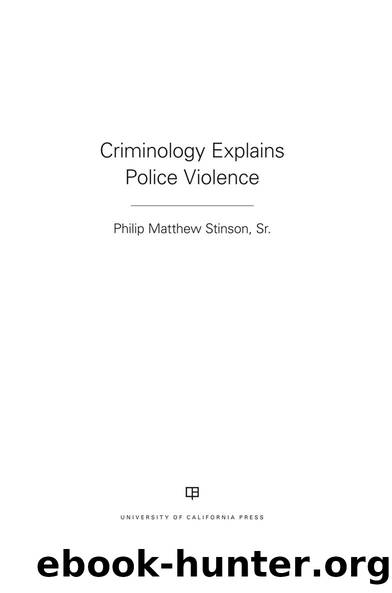Criminology Explains Police Violence by Philip Matthew Stinson Sr

Author:Philip Matthew Stinson Sr [Stinson, Philip Matthew Sr]
Language: eng
Format: epub
Tags: Social Science, Criminology
ISBN: 9780520300095
Google: IQi9DwAAQBAJ
Publisher: Univ of California Press
Published: 2020-01-21T03:32:36+00:00
Denial of Responsibility
Blame is deflected through denial of responsibility as a technique of neutralization. Sykes and Matza explained that delinquent youth often view their own behavior as the result of forces outside of their own control, as if they were a âbilliard ballâ being helplessly propelled into new situations.78 This technique of neutralization helps to understand the context of police violence within the police subculture, in which âdefiant citizensâ are viewed âas provocateurs in need of police control.â79 Further, âWhen police use violence or choose to use the force of law illegally against citizens, they are merely responding to the provocation of citizensâsituations and events that they have little or no control over and for which they are not responsible regardless of their own contributions to the situation or their departure from social expectations.â80
Abusive police officers often rationalize the illegal use of excessive force as the natural consequence of someone elseâs bad acts. I first witnessed this type of police behavior when I was a rookie police officer many years ago. One night on patrol I encountered several teenagers roughhousing on the lawn of a downtown funeral home. It was well after midnight, and the lawn was basking in the bright floodlights that illuminated the outside of the funeral home. I was soon joined by two other officers, including a police sergeant. While we were talking to the teenagers, I was startled whenâwithout any apparent provocation at allâthe police sergeant punched one of the boys in the face, knocking him to the ground. The sergeant then directed me to handcuff the teen and arrest him for assault. The sergeant later said he had no choice but to punch the boy in the face; he said he had been provoked when he noticed that the teenagerâs fist was clenched as he stood talking to us calmly with his hands at his sides. Of course, the teenager never clenched his fist and he posed no threat to the police officers there. But as the sergeant explained to me later that night, âThe good guys always win.â
Download
This site does not store any files on its server. We only index and link to content provided by other sites. Please contact the content providers to delete copyright contents if any and email us, we'll remove relevant links or contents immediately.
The 1921 Tulsa Race Massacre by Chris M. Messer(287)
Introduction to Criminal Justice - A Balanced Approach by Brian K. Payne Willard M. Oliver Nancy E. Marion(254)
Russia's Sakhalin Penal Colony, 1849â1917 by Andrew A. Gentes(249)
Punishing the Poor The Neoliberal Government of Social Insecurity by Unknown(249)
The History of Newgate Prison by Jowett Caroline;(236)
Serial Killers America and UK - 2 BOOKS IN 1 by Clark Matthew(210)
A History of Police and Masculinities, 1700-2010 by David G. Barrie Susan Broomhall(195)
Restorative Justice in Transitional Settings by Kerry Clamp(168)
Organized Crime and Corruption Across Borders by T. Wing Lo Dina Siegel Sharon I Kwok(158)
Culture, Crime and Punishment by Ronald Kramer(155)
Dangerousness, Risk and the Governance of Serious Sexual and Violent Offenders by Karen Harrison(155)
Cops, Cameras, and Crisis by Michael D. White Aili Malm(154)
Policing Gender, Class And Family In Britain, 1800-1945 by Linda Mahood(152)
Routledge Handbook on Immigration and Crime by Holly Ventura Miller Anthony Peguero(151)
The Real CSI by Kate Bendelow(149)
Women Exiting Prison by Bree Carlton Marie Segrave(142)
Losing Legitimacy by Gary Lafree(138)
Using Murder by Philip Jenkins(136)
A Theory of African American Offending by James D. Unnever Shaun L. Gabbidon(135)
